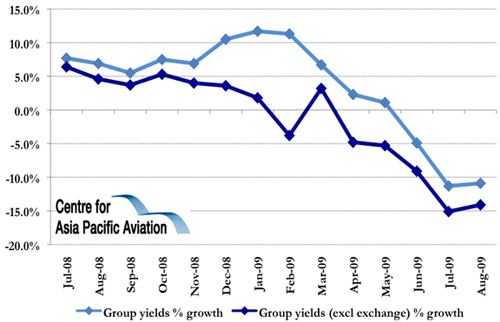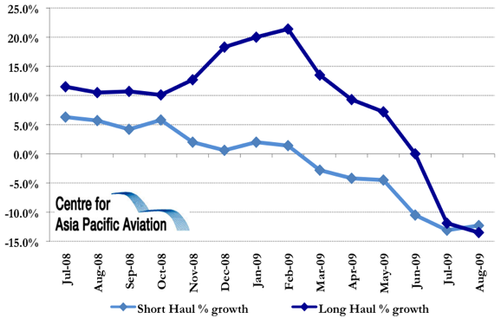Have Air New Zealand's yields bottomed?
The rapid deterioration in Air New Zealand's yields appears to have paused in Aug-2009, with Group yields down 10.9%, following an 11.3% contraction in Jul-2009. Yields, excluding exchange rate effects, fell 14.1% year-on-year last month, following a 15.1% reduction in Jul-2009.
Air New Zealand Group yields including and excluding exchange rate effects (% change year-on-year): Jul-2008 to Aug-2009
But it is probably to early to call a bottoming to the current yield cycle, as Air New Zealand's long-haul yields continued to take a hammering last month falling 13.5%, following Jul-2009's 11.9% contraction.
Short-haul yields remain under pressure following Jetstar's entry in the domestic market, falling 12.3% last month - slightly better than the 13.1% contraction in Jul-2009 and 10.5% reduction in Jun-2009.
Air New Zealand short- vs long haul yields (% change year-on-year): Jul-2008 to Aug-2009
Load factors up in Aug-2009
In more positive news, Air New Zealand's load factors were up in the month, gaining 2.4 ppts, as the carrier reduced capacity (ASKs) by 13.4%. This is an improvement from Jul-2009, in which the carrier experienced a double blow of sharp yield contractions and declining load factors.
In Aug-2009, Air New Zealand transported 924,000 passengers, a 3.0% reduction, as short-haul passenger numbers declined 0.6 ppts, and long-haul passenger numbers slumped by 16.4%.
The carrier reduced capacity on Asia/Japan/UK routes by 24.0% to enable load factors to remain stable at 79.6% despite a 24.1% reduction in demand. Load factors on North America/UK routes were also in line with 2008 levels, with demand down 8.6% on a 7.9% capacity contraction.
Tasman/Pacific capacity was also reduced by 14.5% in the month, primarily through downsizing to smaller aircraft and the withdrawal of trans-Tasman flights from Hamilton and Dunedin, which contributed to the load factor increasing by 6.5 ppts.
More yield pressure ahead - Qantas/Jetstar smell blood
Load factor improvements aside, intense yield pressures are expected to remain.
Jetstar celebrated the launch of the first 100 days of domestic NZ operations on 17-Sep-2009. According to Jetstar, almost 10,000 passengers have flown with the carrier for less than NZD10 one-way, with the carrier handling over 330,000 passengers on its domestic NZ services in the 100-day period (for an average of 3,330 passenger per day).
Jetstar continues to maintain that it has an "active pursuit" of future growth options within the New Zealand market and has plans to rapidly expand its New Zealand presence, moving more A320s into the domestic market.
The Qantas subsidiary's domestic New Zealand business now operates over five routes between Auckland, Christchurch, Wellington and Queenstown and comprising 84 weekly return services.
Also this week, Qantas received the group's 75th B737NG in Auckland, which will serve trans-Tasman routes between New Zealand and Australia (specifically Auckland-Sydney and Auckland-Melbourne services).
The carrier will be adding six of the aircraft, the first three before the end of this year, to its trans-Tasman fleet over the next two years. The new aircraft will each be able to carry approximately 10% more passengers.
Will Pacific Blue target regional destinations with E190s?
Meanwhile, Virgin Blue's offshore arm, Pacific Blue, also firmly established domestically in New Zealand, commenced test flights for its new E190s for international regional and New Zealand services in May-2009. The carrier noted the E190 presents "other tempting opportunities to introduce further competition".
If Pacific Blue does move to E190 New Zealand services, the carrier would target regional markets, which are currently some of Air New Zealand's most profitable routes.
Outlook: Competition to intensify
Air New Zealand continues to experience yield and demand pressures, due to the global economic crisis and increased competition from its Australian counterparts.
This scenario is likely to continue, due to Qantas/Jetstar's aggressive push on the Tasman and in domestic New Zealand markets. Meanwhile, Pacific Blue continues to fight to grow its presence domestically and internationally, with the possibility of utilising Virgin Group Embraer regional jets to access more regional points in New Zealand. All of this will continue the downward pressure on yields.
Overall, Air New Zealand could be heading for another month of double-digit yield reductions in Sep-2009. It is unclear when the current down cycle will truly hit bottom.

